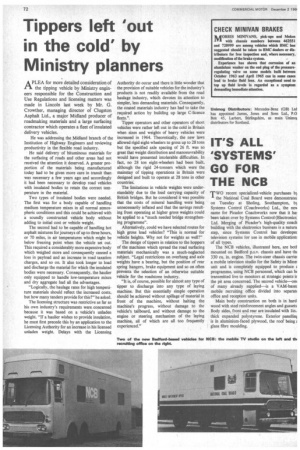Tippers left 'out in the cold' by Ministry planners
Page 74

If you've noticed an error in this article please click here to report it so we can fix it.
APLEA for more detailed consideration of the tipping vehicle by Ministry engineers responsible for the Construction and Use Regulations and licensing matters was made in Lincoln last week by Mr. G. Crowther, managing director of Clugston Asphalt Ltd., a major Midland producer of roadrnaking materials and a large surfacing contractor which operates a fleet of insulated delivery vehicles.
He was addressing the Midland branch of the Institution of Highway Engineers and reviewing productivity in the flexible road industry.
He said delivery of bituminous materials for the surfacing of roads and other areas had not received the attention it deserved. A greater proportion of the materials being manufactured today bad to be given more care in transit than was necessary a few years ago and accordingly it had been necessary to develop road vehicles with insulated bodies to retain the correct temperature in the material.
Two types of insulated bodies were needed. The first was for a body capable of handling medium temperature mixes in all normal atmospheric conditions and this could be achieved with a soundly constructed vehicle body without adding to initial cost or vehicle weight.
The second had to be capable of handling hot asphalt mixtures for journeys of up to three hours, or 70 miles, in air temperatures which might be below freezing point when the vehicle set out. This required a considerably more expensive body which weighed more and consequently caused a loss in payload and an increase in road taxation charges, and so on. It also took longer to load and discharge the material for which the insulated bodies were necessary. Consequently, the haulier only equipped to handle low-temperature mixes and dry aggregate had all the advantages.
"Logically, the haulage rates for high temperature materials should reflect the increased costs, but how many tenders provide for this?" he asked.
The licensing structure was restrictive as far as his own industry's requirements were. concerned because it was based on a vehicle's unladen weight. "If a haulier wishes to provide insulation, he must first precede this by an application to the Licensing Authority for an increase in his licensed unladen weight. Delays with the Licensing Authority do occur and there is little wonder that the provision of suitable vehicles for the industry's products is not readily available from the road haulage industry, which devotes its attention to simpler, less demanding materials. Consequently, the coated materials industry has had to take the required action by building up large C-licence fleets.".
Tipper operators and other operators of short vehicles were rather left out in the cold in Britain when sizes and weights of heavy vehicles were increased in 1964. Theoretically, the new laws allowed rigid eight-wheelers to gross up to 28 tons but the specified axle spacing of 26 ft. was so great that weight distribution and manoeuvrability would have presented intolerable difficulties. In fact, no 28 ton eight-wheelers had been built, although the rigid 24-tonners which were the mainstay of tipping operations in Britain were designed and built to operate at 28 tons in other countries.
The limitations in vehicle weights were understandably due to the load carrying capacity of British bridges. But he considered it was possible that the costs of mineral handling were being unnecessarily inflated and that the savings resulting from operating at higher gross weights could be applied to a "much needed bridge strengthening programme".
Alternatively, could we have selected routes for high gross load vehicles? "This is normal for vehicle heights. Why not for weights as well?"
The design of tippers in relation to the hoppers of the machines which spread the road surfacing mate 'reals mechanically was a much-neglected subject. "Legal restrictions on overhang and axle weights have a bearing, but the position of rear spring hangers, brake equipment and so on often prevents the selection of an otherwise suitable vehicle for the roadstone industry.
"It is, of course, possible for almost any type of tipper to discharge into any type of laying machine. But this essentially simple operation should be achieved without spillage of material in front of the machine, without halting the machine's progress, without damage to the vehicle's tailboard, and without damage to the engine or steering mechanism of the laying machine, all of which are all too frequently experienced."
Uniutog Distributors: Mercedes-Benz (GB) Ltd has appointed James. Jones and Sons Ltd, PG Box 45. Larbert, Stirlingshire, as main Unirnot distributors for Scotland.
































































































































































































